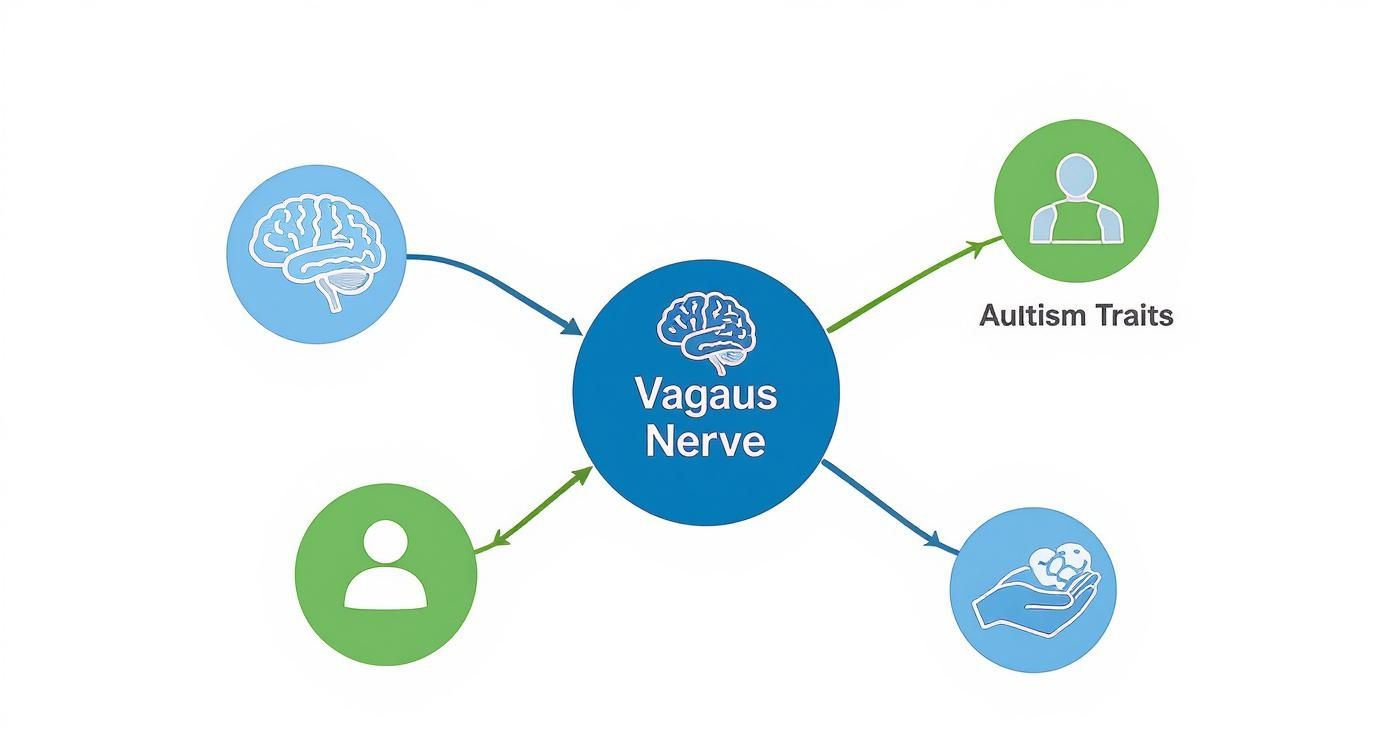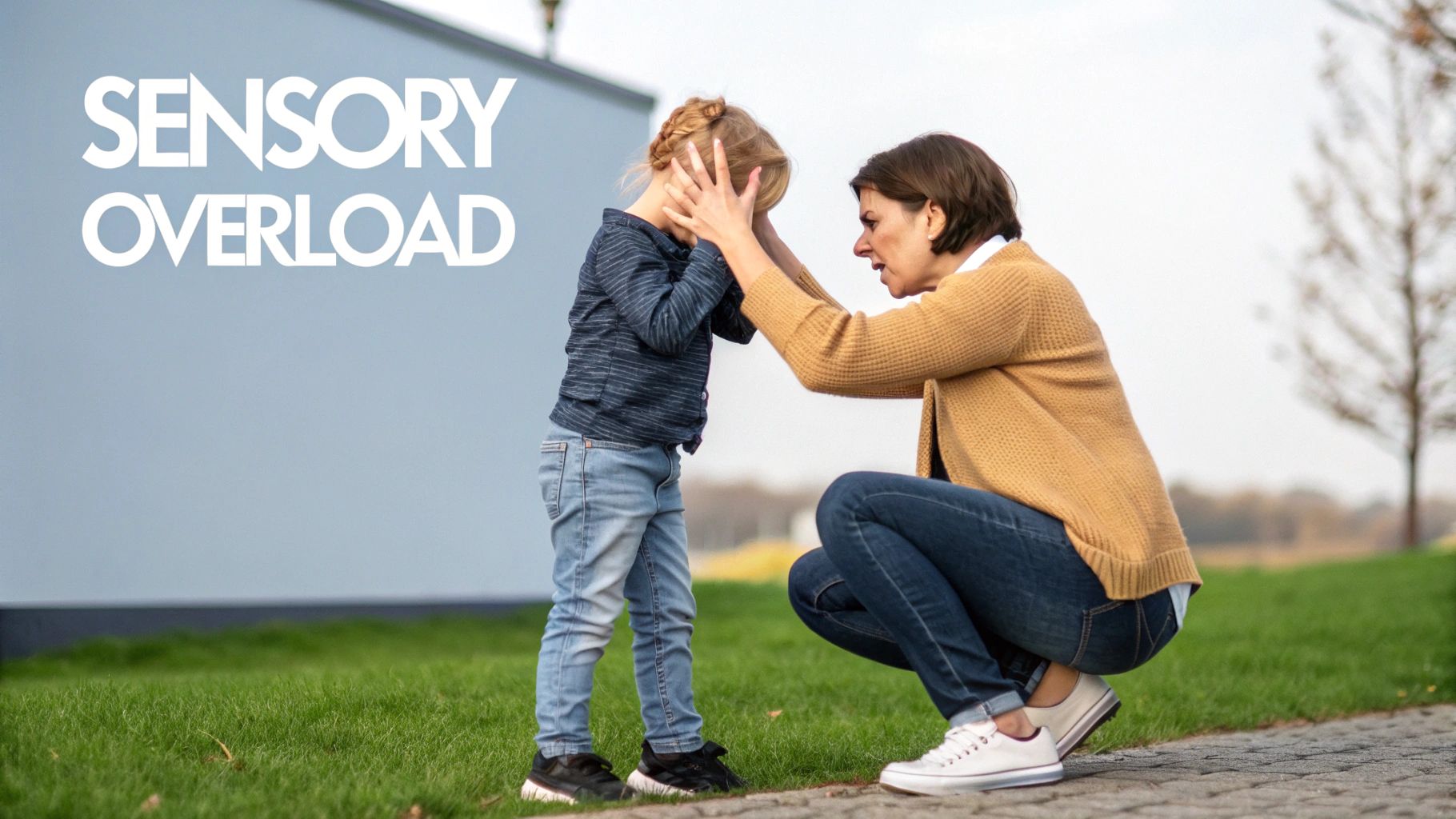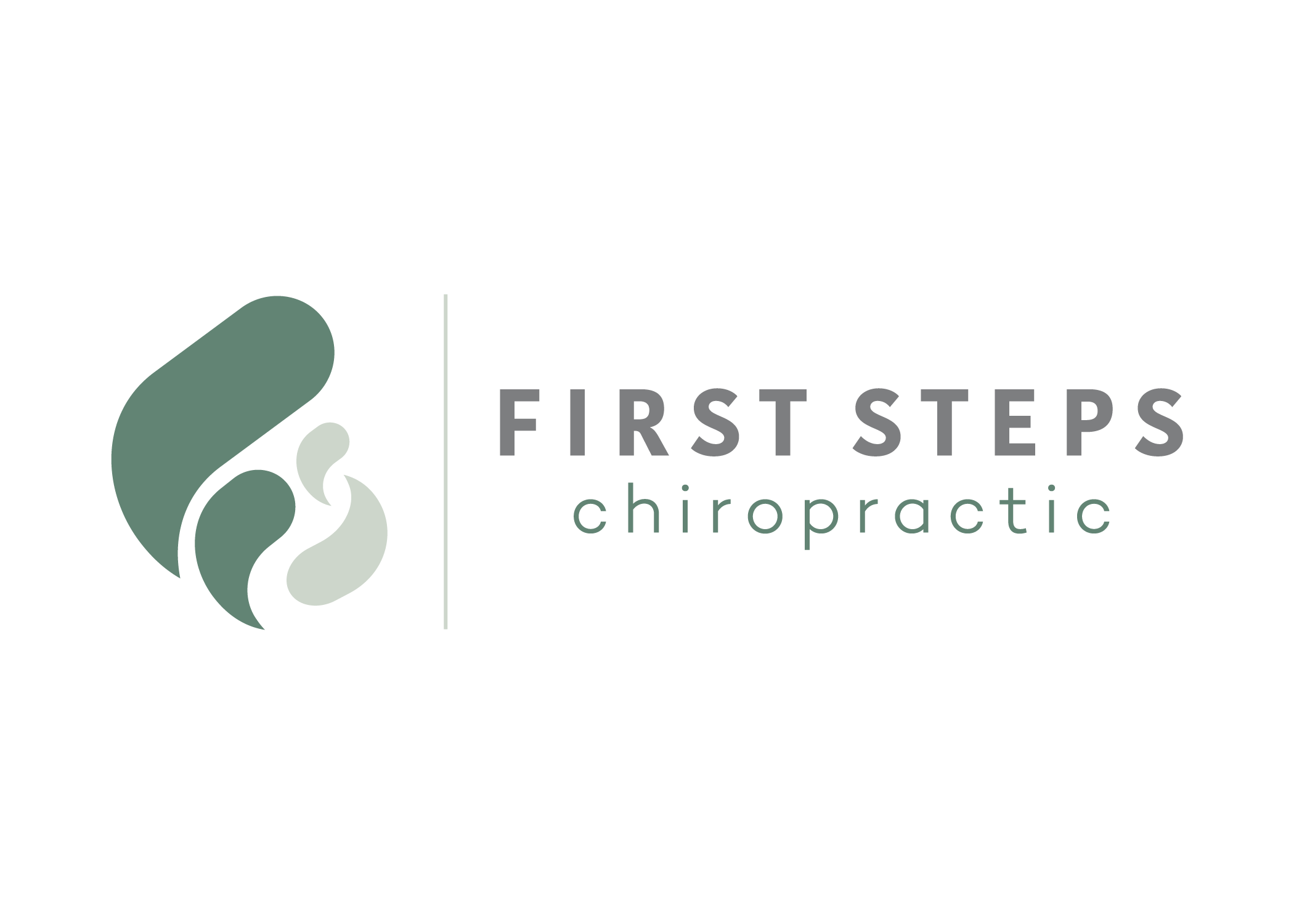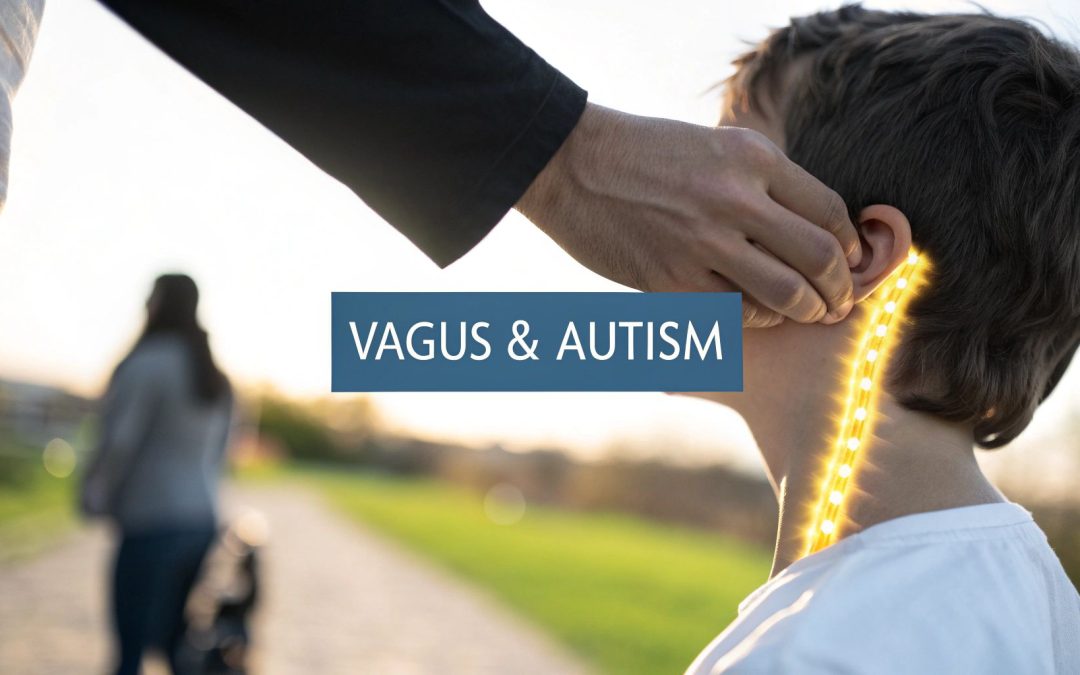The connection between the vagus nerve and autism is a game-changer. It helps us understand why so many kids struggle with sensory processing, social engagement, and emotional regulation. This single nerve is like a superhighway between the brain and the body, and when it’s not working well, the nervous system can get stuck on high alert. Seeing this link gives us a new, hopeful way to support a child’s well-being.
The Vagus Nerve: A Missing Link in Autism Support
For so many parents, navigating the world of autism feels like trying to put together a puzzle with missing pieces. You see the daily struggles—the meltdowns, the social anxiety, the overwhelming sensitivity to sounds or textures—but the why behind it all can be hard to pin down. What if a huge piece of that puzzle is hidden deep within the nervous system, specifically in the function of the vagus nerve?
This isn’t just a new theory; it’s a field of research that is completely reframing how we look at autism. The vagus nerve is the primary driver of the parasympathetic nervous system—the body's "rest and digest" or "safe and social" mode. You can think of it as the brake pedal that slows everything down and brings a sense of calm after a stressful moment.
Why Vagal Tone Matters in Autism
When this nerve has strong, healthy function, which we call high vagal tone, a person can easily shift from a state of stress back to a state of calm. But when vagal tone is low, the nervous system gets stuck in the sympathetic "fight or flight" response. For a child with autism, this can feel like living in a constant state of threat, which dramatically shapes how they experience the world around them.
This isn't just an idea; we see it in clinical research. Autism spectrum disorder (ASD) is increasingly linked to autonomic dysfunction, with the vagus nerve at the center of the conversation. Studies have shown that children with ASD often have significantly lower heart rate variability (HRV), which is a key way we measure vagal tone. This low vagal activity likely contributes to core autism traits like challenges with social communication and heightened anxiety. With the global prevalence of ASD around 1 in 100 children, understanding vagal dysfunction is crucial for millions of families. You can discover more insights about these findings and their implications.
When we look at autism through the lens of the nervous system, behaviors that once seemed confusing can be seen as physiological responses to an internal state of distress. This shift in perspective is the first step toward providing more effective support.
This table breaks down how the abstract concept of "poor vagal tone" can show up in a child's everyday life. These aren't just random behaviors; they're often clues that the nervous system is overwhelmed and struggling to find its calm, "safe and social" state.
Observable Signs of Poor Vagal Tone in Autism
| Challenge Category | Potential Signs Linked to Low Vagal Tone |
|---|---|
| Social & Emotional | Difficulty with eye contact, trouble reading social cues, high anxiety, frequent meltdowns or shutdowns, flat emotional expression. |
| Sensory Processing | Oversensitivity to sounds, lights, or textures; sensory-seeking behaviors (crashing, spinning); picky eating related to food textures. |
| Physiological | Chronic digestive issues (constipation, stomach pain), poor sleep patterns, low muscle tone, shallow breathing. |
| Cognitive & Focus | Difficulty paying attention, challenges with transitioning between activities, feeling easily overwhelmed in busy environments. |
Seeing these challenges through the lens of nervous system function helps us move away from simply managing behaviors and toward addressing the root cause.
By focusing on improving the health of the vagus nerve, we can start to get to the root of many of these challenges, instead of just putting a bandage on the symptoms. This approach gives us a roadmap to help regulate the nervous system, building a foundation of safety, connection, and resilience for children on the spectrum.
Understanding Your Child's Nervous System Switch
To really get to the heart of the vagus nerve and autism connection, let's set aside the complicated medical jargon for a moment. Think of your child’s nervous system like it has a big, simple switch—kind of like a traffic light.
One setting is “red light” mode. This is the sympathetic nervous system, what we commonly call the "fight-or-flight" response. It’s a survival mechanism, pumping the body full of stress hormones like cortisol and adrenaline to deal with a threat. When a child is in this state, they’re on high alert, ready to react to whatever feels overwhelming.
The other setting is “green light” mode. This is the parasympathetic nervous system, or the "rest-and-digest" state. You could also call it the "safe-and-social" system. When this mode is on, the body feels calm and secure. Breathing slows down, digestion works the way it should, and the brain is open to learning, connecting, and engaging with others.
The Role of the Vagus Nerve
So, what controls this switch? That's the job of the vagus nerve. It’s the master conductor of this whole internal system.
The vagus nerve is the physical connection that allows your child to shift from that "red light" of stress back to the "green light" of calm. It’s constantly sending messages from the body up to the brain, reporting on whether the environment feels safe or dangerous. A healthy, well-functioning vagus nerve can hit the brakes effectively after a stressful moment, guiding the nervous system back to its green-light baseline.
We call the efficiency of this internal brake pedal vagal tone. Think of it like muscle tone. Someone with good muscle tone can lift a heavy object without much trouble. In the same way, a child with high vagal tone can manage stress more easily and bounce back to a calm state. Their "brake pedal" is strong and responsive.
When vagal tone is low, it’s like the brake pedal is weak or stuck. A child can get trapped in that red, fight-or-flight mode, even when there's no real danger present. This constant state of high alert can fuel anxiety, sensory overload, emotional meltdowns, and social withdrawal.
This map helps visualize just how central the vagus nerve is, connecting the nervous system to common autism traits and showing where we can offer support.

As you can see, the health of this one nerve radiates outward, touching almost every part of a child's daily experience.
Why This Switch Is So Important for Autism
When that nervous system switch is sluggish or faulty, a child's entire world is colored by it. This isn't a behavioral choice—it's a physiological reality.
For a nervous system stuck in "red light" mode, everyday things can feel like a genuine threat. The hum of the fridge, the tag on a shirt, or a sudden change in plans can trigger an internal alarm. This constant state of alert makes social engagement feel unsafe and makes emotional regulation feel next to impossible.
Understanding this changes everything. We can shift our perspective from trying to manage behaviors to focusing on supporting the nervous system itself. The goal isn't just to address the symptoms but to help repair the underlying switch.
This is where the concept of neuroplasticity gives us so much hope. The nervous system isn't fixed; it can change, adapt, and create new pathways. By providing the right kinds of gentle inputs and support, we can help strengthen vagal tone and make that switch work more efficiently. We're essentially helping the body re-learn how to move from red to green, building a foundation of neurological safety from the inside out.
Improving vagal tone can have a direct, positive impact on a child's life in so many ways:
- Emotional Regulation: With a more resilient nervous system, a child can handle frustrations and transitions with fewer meltdowns.
- Social Engagement: When a child feels safe internally, it becomes easier to connect with others and feel more comfortable in social situations.
- Sensory Processing: A calmer system is less likely to be thrown off by sensory input, which can reduce sensory-seeking or sensory-avoidant behaviors.
- Overall Resilience: Better vagal function builds a stronger capacity to cope with daily life, often leading to better sleep, digestion, and mood.
By focusing on the health of the vagus nerve, we empower the body's own incredible ability to find its way back to balance and calm.
How Nervous System Dysregulation Shapes ASD Traits

When a child’s nervous system is stuck on high alert, it completely changes how they experience the world. Behaviors that might seem confusing or intentional are often just the body’s natural response to feeling constantly under threat. This reframes common ASD traits not as choices, but as the body’s way of trying to cope with an overwhelming amount of internal stress.
Think of it like walking through life with an internal alarm system that never shuts off. The quiet hum from a refrigerator, the bright lights in a store, or even an unexpected hug can feel like genuine dangers. This is the daily reality for so many kids with a dysregulated nervous system, where the vagus nerve and autism connection becomes incredibly clear.
Being trapped in this "fight-or-flight" mode forces all the body's resources toward survival. When that happens, there's very little energy left for social connection, learning, or emotional balance. This constant state of defense is the true root of many daily challenges.
The Physiology Behind Sensory Overload
For a nervous system that’s constantly on guard, sensory information isn’t just processed—it's amplified. The brain loses its ability to filter out what’s irrelevant, causing every single sound, sight, and touch to feel intense and urgent.
This is exactly why a child might cover their ears in a room that doesn’t seem loud to you, or why the tag on their shirt feels unbearable. Their system isn't "overreacting." It is physiologically overwhelmed by sensory input that a well-regulated system would simply ignore.
Social Engagement and Feeling Safe
The vagus nerve is a key player in what’s known as the social engagement system. This incredible network of nerves controls our facial expressions, tone of voice, and our ability to pick up on social cues from others. But here's the catch: for this system to work correctly, the body has to feel safe first.
When a child is stuck in a protective, defensive state, their social engagement system essentially powers down. It becomes biologically difficult to:
- Make eye contact, which can feel threatening or far too intense.
- Read facial expressions or understand the emotion in someone's voice.
- Engage in back-and-forth conversation, because the brain is too busy scanning for danger to focus.
Social anxiety isn't necessarily a lack of desire to connect. More often, it's a physiological inability to do so because the nervous system has prioritized safety above all else. Understanding the deep link between autism and the nervous system gives parents a new lens of compassion for these social hurdles.
A child’s nervous system must feel safe before their social brain can come online. When we see withdrawal or social difficulty, it's often a sign that their internal world is in a state of chaos, not that they are uninterested in connection.
Meltdowns and Shutdowns as a Stress Response
Emotional meltdowns and shutdowns are probably the most misunderstood aspects of autism. They aren't tantrums thrown to get one's way. They are a complete system overload—the neurological equivalent of a circuit breaker tripping when it gets hit with too much power.
When the sympathetic nervous system is pushed far past its breaking point, the body simply can't regulate itself anymore. A meltdown is the external crash, often involving crying, yelling, or big physical movements. A shutdown, on the other hand, is the internal crash, where a child might go quiet and non-responsive as their system desperately tries to conserve every last bit of energy.
Seeing these moments as physiological responses—not behavioral problems—is a game-changer. It shifts the focus away from discipline and toward co-regulation, empathy, and creating an environment that helps the nervous system find its way back to balance. The "why" isn't defiance; it's a desperate cry for safety.
Emerging Research on Vagus Nerve Stimulation
As we get a clearer picture of the link between the vagus nerve and autism, researchers are naturally looking for direct ways to support its function. This has opened up an exciting field focused on Vagus Nerve Stimulation (VNS), which is essentially a way to “exercise” the vagus nerve and strengthen its ability to regulate the entire nervous system.
For years, VNS meant a surgically implanted device, kind of like a pacemaker, that sends gentle electrical pulses to the vagus nerve in the neck. It was originally approved to treat epilepsy and depression, but doctors started noticing something interesting. When individuals had both epilepsy and autism, they often saw improvements that went far beyond just seizure control—things like better mood and communication.
Of course, the idea of surgery is a major hurdle for many families. This has pushed innovation forward, leading to non-invasive approaches that are far more gentle and accessible.
The Rise of Non-Invasive VNS
The most promising of these new methods is called transcutaneous auricular Vagus Nerve Stimulation, or taVNS. It sounds complex, but the idea is simple. The technique uses a small, handheld device connected to an electrode that just clips onto a specific spot on the outer ear.
Why the ear? It turns out a major branch of the vagus nerve runs right under the skin's surface there, making it the perfect spot to send a signal without any need for implants.
Most people describe the sensation as a light vibration or tickle, which makes it a well-tolerated option for kids and teens who might have sensory sensitivities. The goal of taVNS is exactly the same as its invasive big brother: gently activate the vagus nerve, nudging the nervous system out of a high-stress state and into a calmer, "safe and social" mode.
This approach represents a significant step forward, offering a way to directly support the body's primary calming pathway without the need for invasive procedures. It aligns perfectly with a neurologically-focused approach to care.
Even this gentle stimulation can have a real, meaningful impact on the daily challenges that come with a dysregulated nervous system.
What the Science is Showing
While research in this area is still growing, the early results are incredibly encouraging. Scientists are studying how VNS can influence everything from social communication to emotional regulation in people with autism, and the findings suggest a clear link between stimulating the vagus nerve and seeing positive changes.
For instance, a 2022 study on children with both drug-resistant epilepsy and autism who received traditional VNS found a significant drop in autistic behaviors. The biggest improvements were seen in language, social skills, and self-help abilities.
Another large study showed that after 12 months of VNS, a remarkable 62% of individuals with ASD had a major reduction in how often they had seizures. But the benefits didn't stop there. The participants with autism also showed greater improvements in mood and similar gains in alertness and communication compared to their non-autistic peers. You can read the full research on these VNS outcomes yourself.
This growing body of work really shines a light on the potential for VNS to improve quality of life by getting to the root of the issue: nervous system dysregulation. While we still need more research, especially on non-invasive taVNS, it’s one of the most promising areas of support for families navigating the complexities of autism.
Gentle Support Through Neuro-Tonal Chiropractic

While advanced methods like Vagus Nerve Stimulation show incredible promise, many families are looking for gentle, non-invasive ways to support their child's nervous system right now. This is exactly where neuro-tonal chiropractic care comes in, offering a powerful and accessible approach centered on enhancing the all-important brain-body connection—the very foundation of improving vagal tone.
Unlike traditional chiropractic that often targets pain or joint mobility, the neuro-tonal approach has a different mission. Its primary goal is to improve the communication highway between the brain and the body, ensuring signals travel clearly and without interference.
Think of it like having static on a phone line. When there's interference, the message gets garbled and misunderstood. In the body, subtle misalignments in the spine—especially at the very top near the brainstem—can create a similar kind of neurological "static," disrupting the signals traveling along the vagus nerve.
This constant disruption can keep a child’s nervous system stuck in a state of high alert, making it difficult to access the calm, "safe and social" mode needed for regulation and connection. Neuro-tonal care focuses on clearing that static to restore harmony.
Restoring the Brain-Body Connection
Neuro-tonal chiropractors use precise, gentle techniques designed to restore proper signaling within the nervous system. One of the most common methods we use is the Torque Release Technique (TRT).
TRT isn't about manual "cracking" or "popping." Instead, it uses a specialized handheld instrument to deliver a very light, specific impulse to exact points along the spine. This gentle input acts like a targeted reboot for the nervous system, helping to release stored tension and clear the pathways for better communication.
This process helps the body naturally shift out of the sympathetic "threat" mode and into the parasympathetic "safe" mode. When this shift occurs, the vagus nerve can do its job more effectively, leading to direct improvements in vagal tone over time. You can learn more about the specific connection between the vagus nerve and chiropractic care in our detailed guide.
This idea of gentle neuromodulation is also gaining traction in scientific circles. For example, a 2023 study exploring home-based, non-invasive stimulation in children with ASD found that caregiver-administered sessions were highly feasible, with an 88.5% adherence rate over two weeks. The children in the study showed improvements in anxiety and sleepiness, which highlights the potential of gentle, consistent inputs to support nervous system regulation. You can explore the full findings of this feasibility study to see how these approaches are being evaluated.
Building Resilience from Within
The ultimate goal of this gentle care is to build long-term neurological resilience. It’s not a quick fix, but a way to consistently give the nervous system the support it needs to adapt, learn, and self-regulate more efficiently.
By addressing the underlying neurological stress, neuro-tonal chiropractic care helps create an internal environment of safety. This foundation allows a child to better manage sensory input, engage socially, and regulate their emotions.
This approach complements other therapies by making sure the body’s internal communication system is functioning at its best. By focusing on the connection between the vagus nerve and autism, neuro-tonal care offers a gentle, foundational strategy to help a child's nervous system find its way back to balance.
The Path Toward a Calmer Nervous System
When you're navigating the journey of autism, it can feel like you're exploring countless, often disconnected, avenues for support. But what if there was a unifying framework that could change everything? Understanding the profound connection between the vagus nerve and autism offers exactly that—a powerful new way of seeing things.
This perspective shifts the focus away from simply managing behaviors and toward nurturing the root of neurological health. It’s a path forward built on compassion, real understanding, and actionable hope for families.
When we start to see challenges like sensory sensitivities, social anxiety, and emotional meltdowns through the lens of nervous system dysregulation, the picture becomes so much clearer. These aren't choices or behavioral problems; they are the body’s honest, reflexive responses to feeling overwhelmed and fundamentally unsafe. Low vagal tone, which essentially keeps the nervous system stuck on high alert, is so often the underlying reason for these daily struggles.
This understanding allows us to move beyond a symptom-first approach and get to the heart of the matter. The goal isn’t to "fix" autism, but to provide the nervous system with the gentle, consistent support it needs to find its own balance.
Building Resilience From the Inside Out
This is where gentle, neurologically-focused approaches like neuro-tonal chiropractic care come in. These techniques are designed to clear interference in the vital communication pathways between the brain and the body, which in turn helps to improve vagal tone.
By doing so, we empower the body’s own innate ability to shift out of a state of chronic stress and into one of safety and connection. This process builds a stronger, more resilient foundation for emotional regulation, social engagement, and so much more. It truly is about building strength from the inside out.
A calmer, more regulated nervous system is simply better equipped to handle the demands and surprises of daily life. This creates more space for a child to grow, learn, and experience joy.
The ultimate goal is not a cure, but a thriving, resilient nervous system. By supporting the vagus nerve, we help children access their own capacity for calm, connection, and well-being.
This entire path is about creating the right conditions for the nervous system to flourish. It’s about recognizing that a child who feels safe on the inside is a child who can better navigate the world on the outside. For more ways to support this crucial part of the nervous system, you can explore our detailed guide on parasympathetic nervous system stimulation.
If this neurologically-focused perspective resonates with you, the single most important step you can take is to find a practitioner who truly gets it. Look for professionals who have advanced training and certifications in pediatric and prenatal care. These experts have the specific, gentle skills needed to effectively support your child's developing nervous system, helping them build the balanced foundation they deserve.
Frequently Asked Questions
When you're exploring the connection between the vagus nerve and autism, it’s completely normal for a lot of questions to pop up. We get it. Here are some clear, straightforward answers to the questions we hear most often from parents just like you.
Is Low Vagal Tone the Cause of Autism?
No, low vagal tone isn't the direct cause of autism. Autism is a complex neurodevelopmental condition that comes from a mix of genetic and environmental factors.
It's much more helpful to think of autonomic dysfunction and low vagal tone as a major piece of the puzzle. It helps explain so many of the day-to-day challenges we see, like sensory sensitivities, constant anxiety, and social communication struggles. Improving vagal tone is a powerful way to help manage these symptoms and boost quality of life, but it's not a cure for autism itself.
Are Neuro-Tonal Adjustments Safe for My Child?
Absolutely. Neuro-tonal techniques are specifically designed to be incredibly gentle, precise, and safe for all ages, from infants to older kids, even those with significant sensory sensitivities.
Forget what you might think about traditional chiropractic. There is no twisting, popping, or cracking involved here. We use specialized, low-force instruments to deliver a targeted impulse that helps the nervous system regulate itself, all without any discomfort. Of course, it’s vital that you work with a chiropractor who has extensive training and experience in pediatric and neuro-tonal care to ensure your child gets the best possible results.
The focus of neuro-tonal care isn't on the spine or muscles, but on the nervous system itself. These gentle inputs are designed to help the brain and body communicate more effectively, reducing stress from the inside out.
This gentle approach is a perfect fit for children who might be sensitive to touch or wary of new experiences, offering them support without adding more stress to their system.
How Soon Can We Expect to See Changes?
Every child's nervous system is unique, so the timeline for progress will naturally look a little different for everyone. Some parents tell us they notice subtle but positive shifts—in their child’s mood, sleep patterns, or a general sense of calm—within just the first few sessions.
For others, the changes are more gradual, unfolding over several weeks or months as their nervous system starts to learn and hold onto new, healthier patterns of regulation. Consistency is the most important factor for achieving lasting results. Our goal is to build long-term resilience, and a qualified practitioner can give you a more personalized outlook after an initial assessment.
At First Steps Chiropractic, we are dedicated to helping your child's nervous system find balance and resilience. If you're ready to explore a gentle, neurologically-focused approach to support your child's well-being, schedule your complimentary consultation today.

